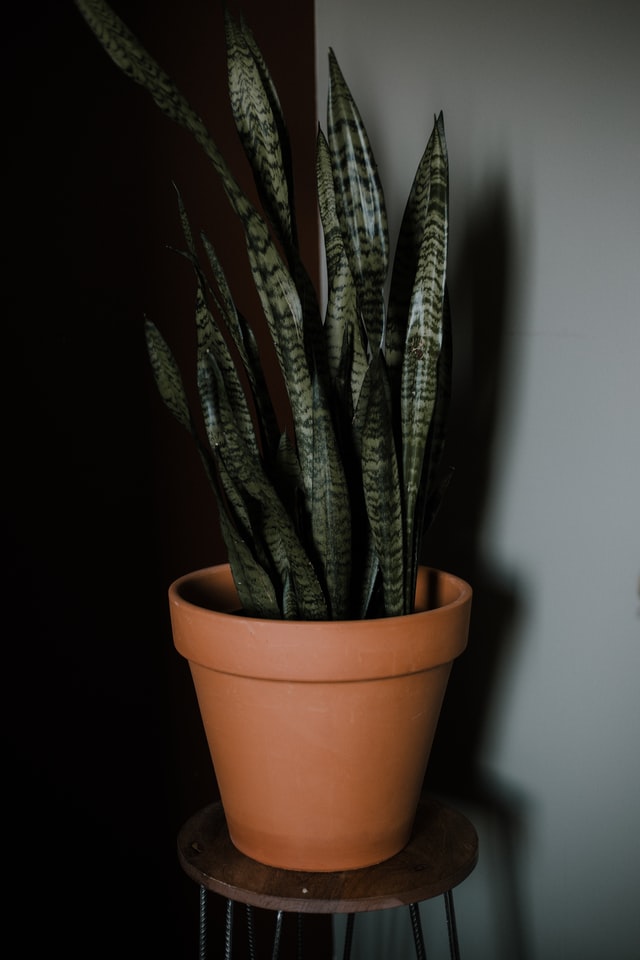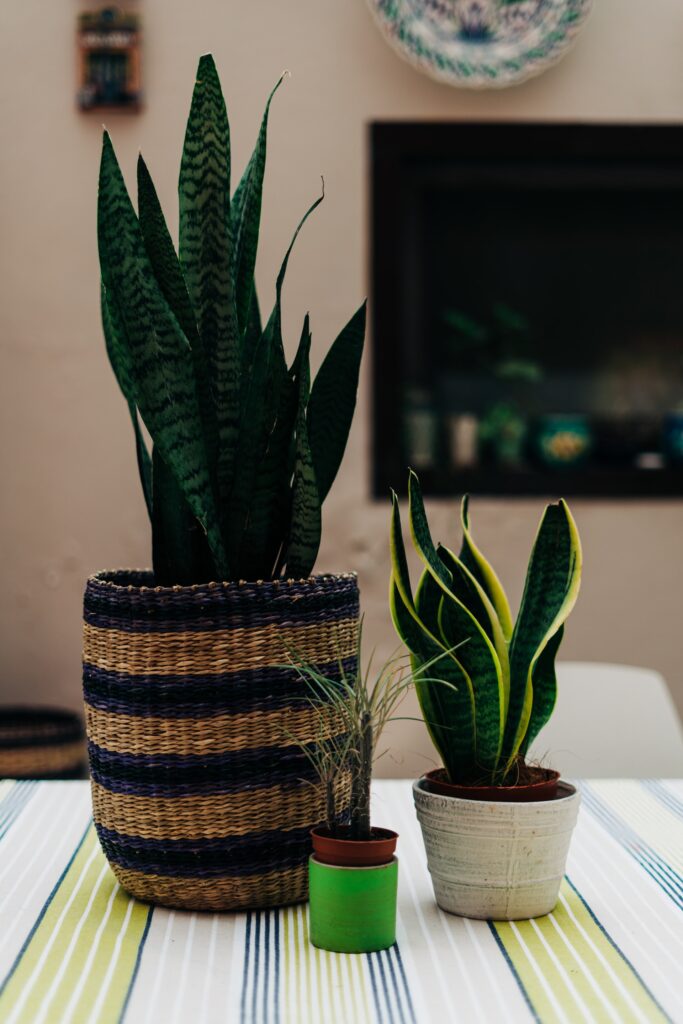The snake plant is one of the most popular plants in the world. It has a number of names, such as St George’s sword, mother-in-law’s tongue and Sansevieria. Snake plants are one of the most popular houseplants in homes, apartments and offices. This is because they are relatively low-maintenance plants that can thrive in a variety of conditions. Snake plants are easy to grow and propagate. They prefer bright, indirect light, humid air, and warm temperature. It prefers bright, indirect light, humid air, and warm temperatures. This article brings to you essential tips on how to do snake plant care ..

Table of Contents
Plant Specification
Common Name : Snake Plant, Viper’s bowstring hemp, St George’s sword
Botanical Name : Dracaena trifasciata(formerly Sansevieria trifasciata)
Family : Asparagaceae
Light Intensity : Shaded , Bright Indirect sunlight
Soil : No waterlogging, well drained
Hardiness Zone : 9-11 (USDA)
Country of Origin : African Continent. Now found all over the world
Toxicity : Toxic to house pets
Types of Snake Plants:
There are various types of snake plants They are characterized by a slender, green leaves with grey or silver horizontal streaks. The Sansevieria genus has around seventy species spread all over the world
Some of the major ones are listed below.
- Bird’s nest snake plant : It is also known as Hahnii. This is relatively small, growing to only 6 inches tall. The leaves’ formation and profile resemble a bird’s nest.
- Cylinder snake plant : This plant has round leaves
- Laurentii Sansevieria : The leaves are characterized by leaves that portray green middle and yellow margin.
- Twisted sister : This is a dwarf variety which grows only upto around 1 ½ feet in height
- White snake plant : It exhibits dark green leaves with white vertical stripes.
- Rhino grass : It is an attractive houseplant that produces a tight clump of vertical leaves. It is known by the botanical name Sansevieria pearsonii
Snake Plant care – Tips :
In a nutshell, snake plant is known as something that require low maintenance , resilient and being hardy which can withstand extreme weather conditions.
Following are the tips to have success in growing snake plant as your indoor plant
Water :
- First of all pot it in a well-drained soil. Do not allow for waterlogging.
- Too much of water will make the plant to rot and die. Water it only when it is totally dry.
Light :
- Do not expose it to direct sunlight.
Brightly lit indirect sunlight suits best for the plant

Snake Plant Benefits :
Apart from being a part in giving uplift to aesthetic appearance of a hall or room in a large building, snake plant has few inherent benefits , some of which are listed below..
a. Purification of Air :
- Just like any other succulent, snake plants help a lot in purification of indoor air.
- This is one of the rarest of rare variety which is capable of converting carbon dioxide (CO2) into oxygen during night time.. This is makes it suitable and most sought after to be placed in bedroom. This quality makes it an ideal plant for bedroom decor, since it can help regulate healthy airflow.
- b .Do away with the toxicity of ambient air
Snake plants exhibit great ability in filtering out the toxic pollutants absorbed in the ambient air. Some of such major pollutants are
- Carbon di Oxide
- Xylene
- Trichloroethylene
- Formaldehyde
- Health Booster
- Though the positive effects of indoor plants with respect to mental health require further medical research and authentication, they definitely play a vital role in horticultural therapy due to the benefits involved.
- Having them placed in large buildings , common work places, hospitals and educational institutions go a long way in helping the above cause
- Easy to care coupled with low maintenance
- First of all, snake plant is easy to care plant. It’s practically maintenance free and hardy, accustomed to even a hostile environment.
- Hence they are often easily grown on public buildings, , apartments and foyers of large buildings.
- They tolerate even diametrically opposite weather conditions.
- Effective against allergies through improvement of indoor air quality
- Snake plants through release of oxygen, improve the indoor air quality. It is pertinent to note here that most of the air born allergies like dust and sander are on account of poor air quality. Snake plant sets it right.
- A little Feng Shui as per Chinese
- As per Chinese belief, snake plant removes negative energy and eliminate negative thoughts and other feelings like bitterness and jealously.
- Can alleviate physical health
- There are other numerous benefits of snake plants which though scientifically not proven , but accepted worldwide by plant experts
For example, they are believed to
- heal Wounds , burns & reduce inflammation
- maintain body parameters like blood pressure
- strengthen the immune system
- be devoid of parasites
- relieve mild headaches through aromatherapy
- Snake plants contain saponins which though poisonous can be used as diuretic , choleretic and laxative drugs
Word of Caution: Never intake any part of the snake plant as they are very poisonous !!

Snake Plant Propagation:.
Snake plants are not just easy to care for , but easy to propagate too.. Only thing, one has to follow the below mentioned points sincerely without fail.
- Chop off a healthy looking leaf near the base joining the stem . Then make an upside-down V cut at the bottom.
- After that place the leaf in a clean container of water. Take care to keep the water level in the container to be slightly above the V cut.
- Once roots have started to form which may take 4-6 weeks depending on the leaf and other external conditions, they can be continued to be kept in water or transferred to soil.
Problems on Propagation:
- Make sure to place the snake plant in a well-drained pot and do not allow waterlogging. It would result in stem rotting. Ensure that soil is moist but well drained always.
- Another major issue is most varieties of snake plant multi colored foliage belong to chimera, a plant mutation that causes the variegated foliage.
- Chimeras can’t be propagated via leaf cuttings as with normal snake plants. Once done , the new plants will lose their coloring, turning into all-green versions.
Disadvantages of snake plant:
So far, we have seen the benefits and care tips of snake plants. But they do come with certain disadvantages which need to be born in mind. Some of major ones are listed below.
Slow Growth :
When placed indoor, snake plant exhibits slow growth. Though the plant loves to expand roots , putting it in a container restricts the root spread . This affects the formation of additional leaves. At the same time, slow growth indirectly helps those who don’t have time to prune it !
Problem in Propagation:
During propagation, one has to take care to cut it correctly, else it will hurt the plant badly.
Also it can’t stand over watering in any case.
Toxicity :
It’s highly toxic for humans as well as pets. Saponin an ingredient of the leaves is very poisonous which plays a major negative role if ingested or chewed.
Leaves falling:
Though they result in uplift of aesthetic appearance of a building, leaves tend to fall any time due to poor health which needs to be attended immediately
Bringing Bad Luck:
Just as most Chinese consider it as part of Feng Shui which brings good luck, there also few who feel otherwise. Though nothing is scientifically proven, if you believe in good or bad luck, then be on safer side.
Cold Temperature Requirement:
Snake plants require a temperature of 55 – 80 deg F during day time and 55 -70 Deg F during night.
Fungus Attack:
Southern blight and Red leaf spot are the major fungal diseases which regularly attack the leaves directly. This totally spoils the beauty of the foliage which otherwise is a treat to watch. One has to pay regular attention to ward off such fungal attacks

Common Problems faced in Snake Plant :
Foul-smelling Soil
- In case the soil smells like it’s rotting, it likely has root rot.
- Scoop out some of the soil if it emits bad odor, the plant can be saved by inspecting the roots after removal of any brown, mushy roots. But one has to be doubly sure if the root system has been saved in time. Else it’s better to discard the total plant immediately before it spreads and spoils the adjacent plants
Yellow or Brown Leaves
- Healthy snake plant exhibits foliage which are green with some silver or yellow streaks.
- Yellow or brown leaves can be on account of including overwatering, pests, and root rot.
- One can come out of each of these conditions if the plant’s water level is managed appropriately. Overwatering results in root rot which can easily expose to pest attack.
Curling Leaves
- Thrips are a common pest infestation that can cause curling leaves. These tiny black bugs are easy to deal with.
- The severely curled leaves need to disposed off and sprayed with neem oil or vegetable soap to keep the pests at bay. This will help new leaves to grow from the stem and the plant will be restored to its original glory.
Leaves Falling Over or Drooping
- Snake plant when healthy grow upward and stand erect. But anything in excess with respect to water light or potting material can make the plant’s leaves droop or flop over.
- If potting mix is not well drained , , the soil becomes soggy and affects the foliage.
This post we have brought in the salient features of snake plant .. Waiting for your views and comments Cheers!

Hiya! I know this is kinda off topic however , I’d figured I’d
ask. Would you be interested in trading links or maybe guest authoring a
blog article or vice-versa? My blog covers a lot of the same subjects as yours
and I feel we could greatly benefit from each other.
If you are interested feel free to shoot me
an email. I look forward to hearing from you! Superb blog
by the way!
sure…would love to contact you